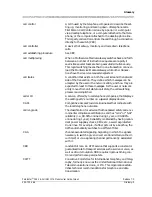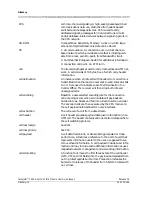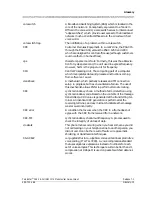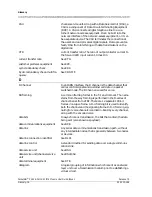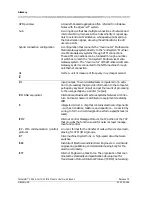
255-700-166
Glossary-23
PacketStar
®
PSAX 6-Port DS1 IMA Module User Guide
, Issue 1
Release 7.0
Glossary
fault monitoring
In network management, the set of functions that (a) detect,
isolate, and correct malfunctions in a telecommunications
network, (b) compensate for environmental changes, and (c)
include maintaining and examining error logs, accepting and
acting on error detection notifications, tracing and identifying
faults, carrying out sequences of diagnostics tests, correcting
faults, reporting error conditions, and localizing and tracing
faults by examining and manipulating database information.
fax demodulation/remodulation
A technique for taking a Group III fax signal and converting it
from, or back to, its original 9.6 Kbps. For example, when a
sheet of paper is inserted into a fax machine, the fax machine
scans that paper into digital bits -- a stream of 9600 bps. Then,
for transmission over phone lines, that 9.6 Kbps is converted
into an analog signal. But if you wish to transmit the fax sig-
nal over a digital line, then it makes sense to convert it back
to it’s original 9.6 Kbps. In essence, this mean you can put
several fax transmissions on one 56 Kbps or 64 Kbps line --
the capacity you’d normally need if you transmitted one
voice conversation, or one analog fax transmission.
FEC
forward error correction. A combination of functions
designed to protect data transmission in a noisy communica-
tions environment, such as traffic transmitted across satellite
and line-of-sight radio-frequency circuits. Most of these types
of circuits transmit at the rate of 2.048 Mbps or slower. The
three stages of FEC are multiple redundancy addressing, cell
encoding, and cell scrambling.
fiber optic cable
Fiber made of extremely pure glass. To date, the best option
for voice/data/video communications, being faster and less
resistant than metal.
FIFO
First In, First Out. A buffering scheme in which the first byte
of data that enters the buffer is also the first byte received by
the CPU.
file transfer protocol
See FTP.
firmware
Software which is kept in semipermanent memory, and is
usually stored in PROMS (programmable read-only memory)
or EPROMS (electrical PROMS). Firmware is used in conjunc-
tion with hardware and software and shares the characteris-
tics of both. It contains software which is so constantly called
upon by a computer or phone system that it is written into a
chip electrically, at higher-than-usual voltage, causing the bits
to retain the pattern as it is "burned in."
fixed-rate connection
A connection whose QoS is determined by a consistent
monthly rate.

